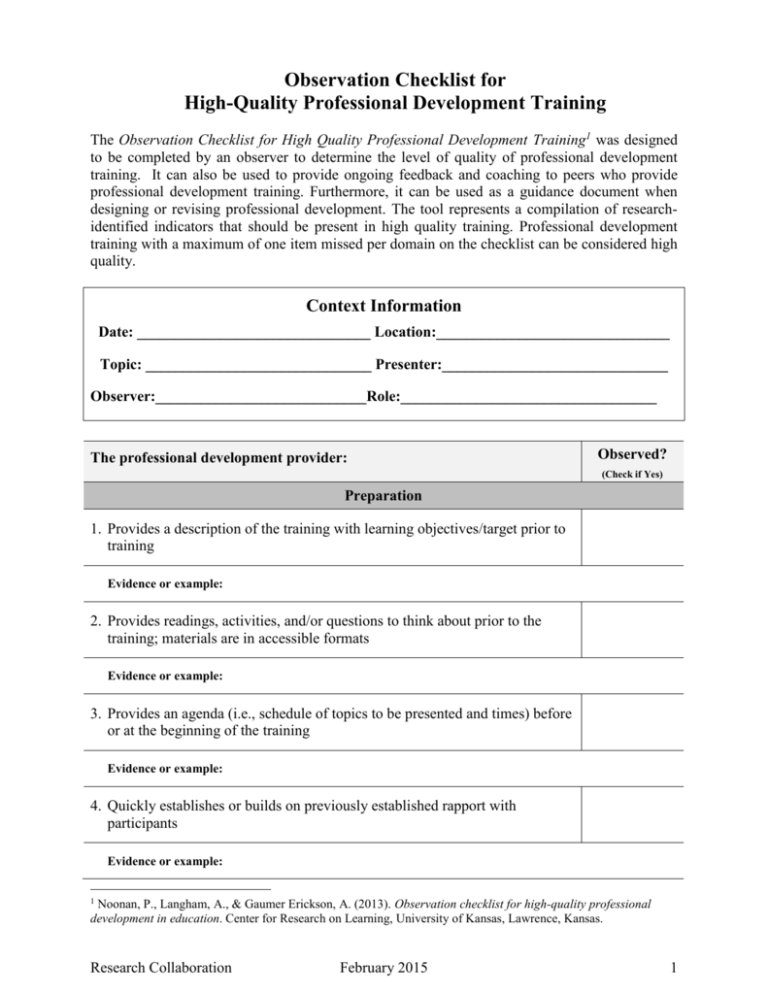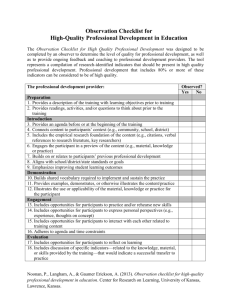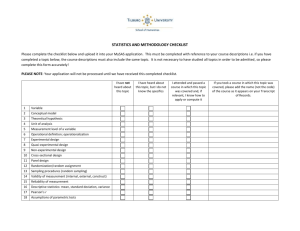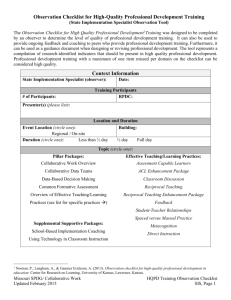HQPD Checklist - Chronicdisease.org
advertisement

Observation Checklist for High-Quality Professional Development Training The Observation Checklist for High Quality Professional Development Training1 was designed to be completed by an observer to determine the level of quality of professional development training. It can also be used to provide ongoing feedback and coaching to peers who provide professional development training. Furthermore, it can be used as a guidance document when designing or revising professional development. The tool represents a compilation of researchidentified indicators that should be present in high quality training. Professional development training with a maximum of one item missed per domain on the checklist can be considered high quality. Context Information Date: _______________________________ Location:_______________________________ Topic: ______________________________ Presenter:______________________________ Observer:____________________________Role:__________________________________ The professional development provider: Observed? (Check if Yes) Preparation 1. Provides a description of the training with learning objectives/target prior to training Evidence or example: 2. Provides readings, activities, and/or questions to think about prior to the training; materials are in accessible formats Evidence or example: 3. Provides an agenda (i.e., schedule of topics to be presented and times) before or at the beginning of the training Evidence or example: 4. Quickly establishes or builds on previously established rapport with participants Evidence or example: 1 Noonan, P., Langham, A., & Gaumer Erickson, A. (2013). Observation checklist for high-quality professional development in education. Center for Research on Learning, University of Kansas, Lawrence, Kansas. Research Collaboration February 2015 1 The professional development provider: Observed? (Check if Yes) Introduction 5. Connects the topic to participants’ context (e.g., community, school, role) Evidence or example: 6. Includes the empirical research foundation of the content (e.g., citations, verbal references to research literature, key researchers) Evidence or example: 7. Content builds on or relates to participants’ previous professional development Evidence or example: 8. Aligns with standards or goals valued by the participants (e.g., laws, professional organization standards, local policies) Evidence or example: 9. Emphasizes impact of content on beneficiaries’ outcomes (e.g., clients, patients, students, families) Evidence or example: Demonstration 10. Builds shared vocabulary required to implement and sustain the practice Evidence or example: 11. Provides examples of the content/practice in use (e.g., case study, vignette) Evidence or example: 12. Illustrates the applicability of the material, knowledge, or practice to the participants’ context Evidence or example: Engagement 13. Includes opportunities for participants to practice and/or rehearse new skills Evidence or example: Research Collaboration February 2015 2 Observed? The professional development provider: (Check if Yes) 14. Includes opportunities for participants to express personal perspectives (e.g., experiences, thoughts on concept) Evidence or example: 15. Facilitates opportunities for participants to interact with each other related to training content Evidence or example: 16. Adheres to agenda and time constraints Evidence or example: Evaluation 17. Includes opportunities for participants to reflect on learning Evidence or example: 18. Includes specific indicators—related to the knowledge, material, or skills provided by the training—that would indicate a successful transfer to practice Evidence or example: 19. Engages participants in assessment of their acquisition of knowledge and skills Evidence or example: Mastery 20. Details follow-up activities that require participants to apply their learning in a new setting or context Evidence or example: 21. Offers opportunities for continued learning through technical assistance and resources Evidence or example: 22. Describes opportunities for coaching to improve fidelity of implementation Evidence or example: Research Collaboration February 2015 3 Authors’ Note: This checklist is not designed to evaluate all components of professional development, because as Gusky (2000) points out, professional development is an intentional, ongoing and systemic process. However, training (e.g. workshops, seminars, conferences, webinars) is the most common form of professional development because it is “the most efficient and cost-effective professional development model for sharing ideas and information with large groups” (p. 23). Therefore, this checklist is designed to improve and evaluate the quality of training. References Archibald, S., Coggshall, J. G., Croft, A., & Goe, L. (2011). High-quality professional development for all teachers: Effectively allocating resources (Research and Policy Brief). Retrieved from National Comprehensive Center for Teacher Quality website: http://www.tqsource.org/publications/HighQualityProfessionalDevelopment.pdf Cooper, J. D. (n.d.). Professional development: An effective research-based model. Houghton Mifflin Harcourt. Available at http://www.washingtonstem.org/STEM/media/Media/Resources/Professional-DeveloPmentAn-Effective-Research-Based-Model-COOPER.pdf. Duda, M. A., Van Dyke, M., Borgmeier, C., Davis, S., & McGlinchey, M. (2011, February). Evidence-based professional development. Presented at the 2011 State Personnel Development Grants Regional Meeting, Washington, DC. Dunst, C. J., & Trivette, C. M. (2009). Let’s be PALS: An evidence-based approach to professional development. Infants & Young Children, 22(3), 164-176. Guskey, T.R. (2000). Evaluating professional development. Thousand Oaks, CA: Corwin. Hunzicker, J. (2010). Characteristics of effective professional development: A checklist. Unpublished manuscript, Department of Teacher Education, Bradley University, Peoria, Illinois. Joyce, B., & Showers, B. (2002). Student achievement through staff development (3rd ed.). Alexandria, VA: Association for Supervision and Curriculum Development. Knowles, M. S. (1980). The modern practice of adult education: From pedagogy to andragogy. New York: Cambridge. Knoff, H. M. (2011). Arkansas SPDG research-based professional development: Evaluation form. Unpublished instrument. Learning Forward. (2012). Standards for Professional Learning. Retrieved from, http://learningforward.org/standards-for-professional-learning#.U-EvhPldXFo. National Research Council. How People Learn: Bridging Research and Practice. Washington, DC: The National Academies Press, 1999. Trivette, C. M., Dunst, C. J., Hamby, D.W., & O’Herin, C. E. (2009). Characteristics and consequences of adult learning methods and strategies (Winterberry Research Synthesis, Vol. 2, No. 2). Asheville, NC: Winterberry Press. Wei, R. C., Darling-Hammond, L., & Adamson, F. (2010). Professional learning in the United States: Trends and challenges. Dallas, TX: National Staff Development Council. This evaluation instrument was developed under a grant from the US Department of Education, #H323A120018. However, those contents do not necessarily represent the policy of the US Department of Education, and you should not assume endorsement by the Office of Special Education Programs. Research Collaboration February 2015 4


![Assumptions Checklist [Word File]](http://s3.studylib.net/store/data/005860099_1-a66c5f4eb05ac40681dda51762a69619-300x300.png)





